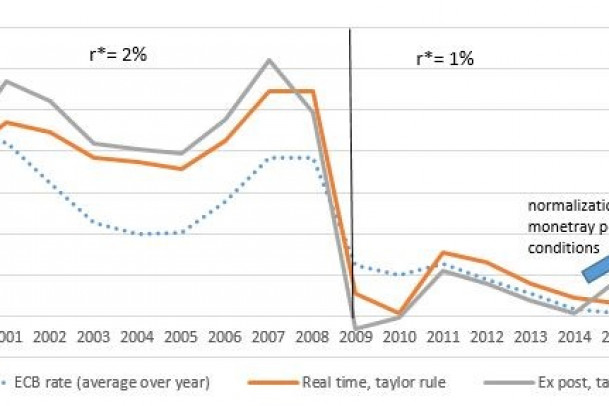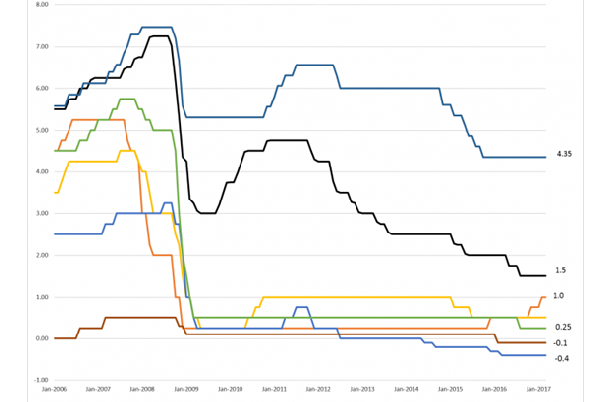In 2016, growth remained sluggish, driven by public consumption and to a lesser extent, by private consumption and external trade. The Abenomics policies have not given the expected results: the risk of deflation persists, the level of public debt is still very high.

Growth prospects in 2017 remain limited. Indeed governmental support measures for the activity have been reduced. Private consumption will always support business, but its dynamics remain modest, wages still have not taken off despite a tight labour market (unemployment rate at the lowest around 3%). Wage growth is still hampered by the tendency of companies to insufficiently redistribute their profits, and by the rigid structure of the Japanese labour market (low mobility and marked duality). Also the same slight rise in inflation has a negative effect on real wages.
Foreign trade is expected to be sluggish, and would increase slightly under the effect of a more favourable business partners environment while being hampered by the past appreciation of the yen. Private investment will remain sluggish due to significant investors’ wait and see attitude, although profits, corporate liquidity and financial conditions are still favourable. The still accommodative monetary policy would support the activity (deposit rate at -0.1% and asset purchase program of 80,000 billion yen per year). In September 2016, the monetary policy framework evolved by introducing rate curve control, including a long-term interest rate target.
THE COUNTRY IS FAR FROM THE CONSOLIDATION OF PUBLIC FINANCES
The public deficit should stabilise at a high level in 2016. The increase in social spending significantly weighs on the state budget while revenues are insufficient. However, the government decided to postpone the VAT rise again from 8% to 10% until October 2019. While in 2016 the stimulus packages have multiplied (the last of which was 1.5% of GDP for the 2016/2017 fiscal year), their effects would be lower in 2017. The current trajectory of the debt does not appear sustainable, especially as health costs continue to increase with the ageing population.
The prospect of the 2020 Olympics and the increase of expenditures brought as a result thereof is not expected to foster a recovery path. The government's goal of achieving a primary surplus by 2020 would appear unrealistic.
In addition, as US elections reversed the yen appreciation trend, downward pressures are expected given the expected strengthening of the dollar and the global environment of risk aversion. Improved exports would be offset by increased imports due to moderate growth in domestic demand and higher energy costs. The services account will continue to consolidate as a result of increased tourism, particularly for Chinese tourists (20 million tourists would be targeted by 2020) and the revenue balance will remain significant.
Although exports may be hampered by the appreciation of the yen against the dollar, they could bear this effect because of the relatively favorable demand from their trading partners. In addition, as US elections reversed the yen appreciation trend, downward pressures are expected given the expected strengthening of the dollar and the global environment of risk aversion.
THE TRANS-PACIFIC PARTNERSHIP (TPP) AT RISK
In September 2015, Shinzo Abe was reappointed to head the LDP (Liberal Democratic Party in power) and his party now holds half of the seats in the Senate following the senatorial elections held in July 2016. The party should dominate the political scene in 2017. US President-elect Donald Trump announced the rejection of the TPP which aimed to harmonise standards by reducing tariffs and to counteract the growing influence of China. Although the Japanese Parliament had ratified the agreement on 9 December, the TPP cannot be implemented without the United States.
While the country wants to maintain close relations with this country so as to avoid being isolated in Asia, this is bad news for Japan, this defender of free trade. China would have more free rein regarding the implementation of the Comprehensive Economic Regional Partnership (RCEP) which excludes the United States.
Also new nuclear tests carried out by North Korea in 2016 were condemned by Japan, which called on the international community to adopt new sanctions.
Strengths:
- Privileged location in a dynamic region
- Very high level of national savings (around 23% of GDP)
- Public debt 90% owned by local investors
- Advanced technology products and diversified industrial sector
Weaknesses:
- Difficulty of consolidating public finances and bringing an end to deflation
- Reduction of the workforce and increasing share of precarious workers
- Political instability
- Low productivity of small and medium companies
http://www.coface.com/Economic-Studies-and-Country-Risks/Japan









